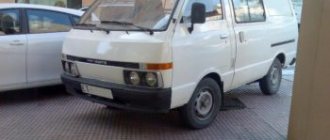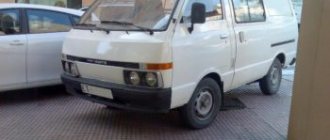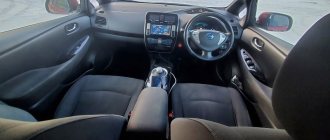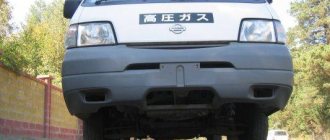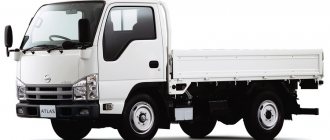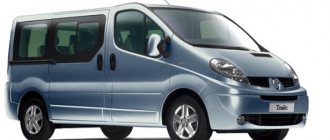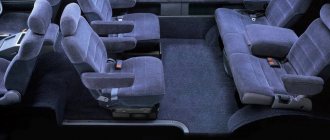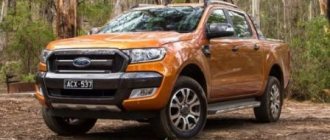The Nissan Vanette was first released in 1979. Produced in minibus and flatbed truck formats. Capacity ranged from 2 to 8 people.
Gasoline engines that were installed on cars:
- SR20DE
- GA16DE
- Z24i
- Z24S
- Z20S
- A14S
- A15S
- A12S
Engine generations:
- C120. Produced from 1979 to 1987.
- C22. Produced from 1986 to 1995.
- C23. Produced from 1991 to the present.
Until 1995, production was located only in Japan. Afterwards, production facilities were moved to Spain. Door options, number of seats, body glazing, modifications differ depending on the year of manufacture. The manual transmission for the engine was available in 4-speed and 5-speed versions. Starting with the C23 generation, automatic transmissions began to be installed. There are all-wheel drive and rear-wheel drive car models.
The Nissan Vanette drive axle is located at the rear. The front suspension is double-wishbone torsion bar. The rear suspension can be spring or spring. The 23 Series is further divided into Cargo or Serena vehicles. Currently, the car replenishes the segment of passenger and commercial transport. Cargo vans and utility vehicles are marked SK 82. Passenger trucks are marked SK 22.
What engines were installed?
First generation of engines
| Engine make | Specifications |
| GA16DE | 1.6 l., 100 hp |
| SR20DE | 2.0 l., 130 hp |
| CD20 | 2.0 l., 76 hp |
| CD20T | 2.0 l., 91 hp |
Second generation engines
| Engine make | Specifications |
| CA18ET | 1.8 l., 120 hp |
| LD20TII | 2.0 l., 79 hp |
| CA20S | 2.0 l., 88 hp |
| A15 | 1.5 l., 15 h.p. |
Third generation of engines
| Engine make | Specifications |
| L8 | 1.8 l., 102 hp |
| F8 | 1.8 l., 90-95 hp |
| RF | 2.0 l., 86 hp |
| R2 | 2.0 l., 79 hp |
The engine number is located on the right side at the junction of the head and block on a flat area. Another option: on a horizontal cut to the left of the first candle on a small area.
Technical characteristics of cars of the Nissan Vanette model range
| I | II | III | IV | |
| Start year of release | 1978 | 1985 | 1994 | 1999 |
| Model | S120 | S22 | S20, SE, SK | S21, SK |
| Dimensions, m | 3.9x1.6x1755 | 4.36x1.69x1.9 | 4.365x1.69x1.9 | 4.285x1.69x1.985 |
| (Cargo 2.3D) | 4.5x1.695x1.98 | |||
| Clearance, cm | 17 | 15-18,5 | 18,5 | 17 |
| Load capacity, kg | 600-865 | 750-865 | 600-1000 | 750 |
| Turning radius | 4,6-4,9 | 4,3-5,1 | ||
| Tire size | 195/70R15 92Q | 195/70R14 90S | 175/R14-6PRLT | |
| Wheelbase, m | 2,075 | 2,35 | 2,735 | 2,22 |
| Power steering | No | Yes | Yes | Yes |
| Fuel tank, l | 50-55 | 60 | 60 | 53 |
What to choose
Nissan minibuses, which have a 1.8 liter gasoline engine, are very popular among car enthusiasts. Atmospheric diesel engines with a volume of 2.2 liters are almost equally in demand. There is an interesting option for turbocharged cars. The engine volume in this case is 2 liters. Everyone decides for themselves whether to give preference to an automatic or manual transmission, based on their personal needs. In any case, the unit is distinguished by its unpretentiousness, reliability, and low fuel consumption. Able to start in cold weather.
Is it worth buying?
Why exactly does the buyer choose Nissan Vanette? Everything is very simple. The truck is ideal for transporting cargo up to 1 ton. Many versions have all-wheel drive. The car from Japan is a worthy competitor to such popular cars as Ford Transit Connect and Renault Traffic. The latter, by the way, are expensive in terms of spare parts for repairs, and they cost much more.
The price tag for another analogue of Vanette - Toyota Hiace is quite high, so not every driver can buy such a vehicle. In turn, Toyota Town Ace is inferior to Nissan in terms of cargo compartment volume, as well as load capacity. In addition, the cost of the car is also higher. Thus, Bongo-Vanette is superior to its analogues in many respects.
It is better to purchase a cargo or cargo-passenger Nissan in Vladivostok. Available equipment in the Far Eastern city is cheaper, is in more or less acceptable condition, and has a lower mileage. You can also find interesting options in Novosibirsk or Barnaul, where you can easily purchase an all-wheel drive five-door car produced in 2004 for 340-370 thousand rubles.
On the secondary market you can easily find cars with a mileage of about 100 thousand kilometers, which is not much for a used car. Such vehicles, as a rule, belong to the year 2006-2007. The cost is naturally higher - about 450 thousand rubles.
Brand history
The triumphant march of the model began in the fall of 1978. Then the Japanese automobile concern released its new brainchild on the roads simultaneously in three body styles. This is a minibus for eight passengers, a cargo van with two passenger seats in the front and a flatbed truck with a double passenger seat in the cabin. The most attractive thing about this car was and remains that it can be driven with a driver's license for a passenger car. From the first days of its existence, the Nissan Vanette has become a reliable assistant among lovers of family holidays and travel, supporters of small businesses and simply an irreplaceable universal car.
Nissan Vanette interior
The developers of the Nissan Vanette were not the pioneers of this class of cars. The idea of a “carriage” for more than 4 passengers simultaneously shrouded many design bureaus in its haze. But after the Mazda team managed to create and launch its Mazda Bongo model into series in 1966, Nissan engineers first had to wait patiently for eleven years until competitors (or like-minded people) had something that they could take as a base for creating your own legend. Creatively and skillfully redesigned.
For Mazda representatives, such a story would amuse their pride. But in the collection of Nissan models there were Nissan Sunny Cab 20 and Nissan Cherry Cab 20 with rear-wheel drive, both born in 1969.
Nissan's collection of models included the Nissan Sunny Cab 20 and Nissan Cherry Cab 20 with rear-wheel drive, born in 1969
They had minor differences, but they laid the foundation for the “Vanka” coverover. Why cab-over? This type of truck layout involves a cab without a hood that sits on top of the engine, which is located above the front axle. Cab 20s were typical cabovers. Many 1st generation Vanettik models traditionally bore the title Cherry or Sunny. Its first representatives came out under the name Datsun C20, then Nissan C20 or Nissan Datsun C20. And only a little later, the entire first generation was united under the Nissan Vanette C120 brand.
While the 1966 Mazda Bongo had a rear engine. Like the “humpbacked” Zaporozhets or Porsche. The engine on the Cab 20 was already located in the area of the front row of seats.
When preparing the Largo model for release, Nissan engineers weighed the car and determined that it would be most optimal if the power unit was pushed 40 cm deep into the cabin and positioned strictly between the front seats and the front axle. Thanks to this, it was possible to achieve balance between the front and rear of the car. The "geographical center" or center of gravity was now on the front axle.
1st generation
Nissan first introduced the Vanette minivan back in 1978. The model replaced the Nissan Cherry Cab (Sunny Cab C20). Initially, 3 modifications of the car were available: a 9-seater minibus (Coach version), a truck and a van with the ability to transport passengers. At the same time, it was possible to drive a Nissan Vanetta with a category “B” driver’s license. The car immediately became very popular in Japan and Europe. The very idea of creating such a model was not new; by that time, many brands had expanded their line with similar machines. The Nissan Vanette has a classic appearance for this class: large round headlights, slightly awkward body lines and a standard bumper.
A year later, the Japanese brand introduced a version with an extended wheelbase. Later, a luxury version of the model with a swivel driver's seat appeared. This solution turned out to be innovative. The evolution of the Nissan Vanette continued. In 1982, further design changes took place: the air conditioning system was improved, front disc brakes and a new instrument panel appeared.
2nd generation
In 1986, the second generation of the minivan premiered. External changes were immediately noticeable. The angular contours of the body have been preserved, but the car has become more proportional and interesting. A line of engines, consisting of injection and carburetor engines with a power of 88-120 hp. replenished with a 2-liter turbodiesel (79 hp). Versions with a 4-speed automatic transmission also appeared. Certain improvements have also been made in the design. The quality of finish has improved, and the model has become easier to operate.
3rd generation
In 1994, the Japanese concern introduced the third generation of the Nissan Vanette. The car remained rear-wheel drive, but the layout became more modern - single-volume. The model was made in the European style, but it retained the outlines of its predecessor. The body received a half-hood layout (the front axle and engine were moved forward of the cabin under the first row of seats). This solution made it possible to make the weight distribution ideal. The vehicle's carrying capacity has also increased slightly - to 535-740 kg, useful volume - to 4.8 cubic meters. Changes also occurred in the motor range. The minivan was offered with a 1.6-liter unit (98 hp), a new 2-liter engine (126 hp) and a 2-liter CD20T diesel engine (66 hp). Improved power plants have made the Nissan Vanette more economical and dynamic. In 1995, a 2.3-liter diesel engine (135 hp) was added to the engine line. The engines were equipped with a 5-speed manual transmission. An optionally modified “automatic” was offered. In the same year, the production of new modifications Vanette Cargo and Vanette Combi began.
4th generation
In 1999, the fourth generation Nissan Vanette was shown to the public. Among the main features of the new product are a simple interior trim, a rounded body design, interesting headlights, a bumper that protrudes forward and an expanded range of engines. The car has remained a reliable and practical vehicle with many different modifications. In Russia, the model was not as popular as in the West.
Nissan Vanette has an almost ideal interior layout, which was developed specifically for transporting cargo and long trips. Despite many modifications, the most popular were passenger and semi-truck models. They are still actively exploited today.
Minibus at work
Vanetta's professional aptitude is excellent. For example, sliding doors on both sides installed on a minibus greatly simplify loading. Boxes and drawers can be removed from any position without any problems. The doors, including the back one, are quite wide. The ability to lift 1 ton of payload on board is undoubtedly pleasing. Although the minibus does not “tear” from its place, it moves confidently. The short wheelbase allows for successful maneuvers in confined spaces. The only thing that slightly darkens the situation is the stiff suspension, which, along with the short wheelbase, creates problems when driving over speed bumps.
Reviews
- Artem Vitalievich: purchased a 1992 Nissan Vanneta in September 2012. Despite its advanced age, the car looked very good. I decided to take this particular model because I had heard about Japanese quality. Externally, the car was not very pleasing - an angular, inconspicuous minivan. However, inside the Nissan Vanneta was spacious and allowed to transport a lot of things. I took the version with a 2-liter diesel unit with 80 horsepower. With this engine, the car drags everything. Large overload is not a problem for her. The car's speed is not very good. I accelerated it to a maximum of 110 km/h, but that was quite enough for me. The car itself is nimble and agile, it is perfect for urban conditions. Consumption on the highway is about 8 liters, in the city - just over 10 liters. It took me a long time to get used to the absence of a hood, but driving with this arrangement turned out to be even easier. There were no whims during 4 years of work. Naturally, we had to periodically change consumables and inspect the car (it’s quite old). Among the shortcomings, I note the simple interior trim (cheap materials), poor sound insulation and a noisy unit.
- Maxim, Vladivostok: bought a Nissan Vanneta in 2012. At that time the car was 2 years old. The model was a gable one with a manual gearbox and an R2 engine. The diesel 4-cylinder unit works quite well, but the electronic brains of the fuel injection pump soon began to cause problems. It sometimes took up to 6 minutes to start. As a result, we had to replace the element with a standard mechanical injection pump. After that everything became fine. In general, repairing a Nissan Vanneta often becomes a big problem. So, it took me about an hour to change a burnt out light bulb. Another disadvantage was the weak suspension. After 3 years of work I had to change it. The engine is very demanding on fuel, so it is better to fill the car with good diesel fuel. Otherwise, the Nissan Vanneta is a typical Japanese car, combining high reliability and performance.
Maintainability
It doesn’t matter whether the engine consumes gasoline or diesel, the Vanetta is reliable. Most users respond positively. Families with children (in the case of a minibus) and entrepreneurs (cargo-passenger and cargo transportation) are especially pleased with the “bus”. Nissan Vanette requires standard maintenance. Periodically, due to mileage, the starter fails. Similarly, the timing belt may need to be replaced.
It is quite possible to find a fully contract power unit on the used market for a reasonable price. Moreover, sellers, if necessary, organize delivery to regions of the country. Moreover, all engines are documented, time is allocated to check their performance, and the product is tested before shipping. As a rule, the kit includes the necessary attachments, including power steering, starter, turbine, scythe, generator and air conditioning pump. The exception is the presence of a gearbox, the presence of which significantly affects pricing.
Device
Nissan Vanette belongs to the category of trucks and has a design characteristic of this class. The model is available in the following versions: chassis with cab (Truck), van (Practic and Van), variation with an on-board platform and a small minibus (Combi) with a capacity of 2 to 8 people. The car is popular in families where one of the members has a category B driver's license.
The latest generation of Nissan Vanette is characterized by rounded shapes and a frame design. This arrangement makes the car very stable and durable. The machine confidently transports loads in excess of the declared weight. At the same time, the chassis allows the installation of various body types, which increases the capabilities of the model.
The Nissan Vanetta uses a spring or spring variation as a suspension. The latest versions usually use spring suspension with 2 arms in the front. The drive axle is located at the rear. The basic version is rear-wheel drive, but all-wheel drive modifications are also available. It's quite easy to distinguish them. If the car has rear-wheel drive, then the VN index appears in the name. All-wheel drive is designated in the markings by the letters MN.
The Nissan Vanette's braking system is standard. The latest generations use disc brakes, while earlier versions use drum brakes. The hand brake is of a mechanical type.
The main one for the car is a manual transmission (4- or 5-speed). An automatic transmission is available as an option.
The interior of the Nissan Vanette is very thoughtfully designed. A fairly simple dashboard and a comfortable steering wheel with various adjustments ensure comfortable driving. The driver's seat is adjustable in several directions. All seats are upholstered in velor and have armrests. An additional advantage is the transformable interior, which allows you to free up space or adjust the space for specific purposes.
Among the main disadvantages of the model are:
- slight noise when changing gears;
- weak cardan shaft crosspieces (this problem is typical for all rear-wheel drive cars).
